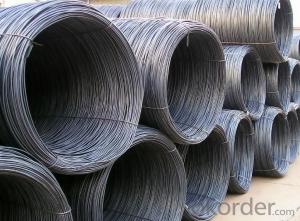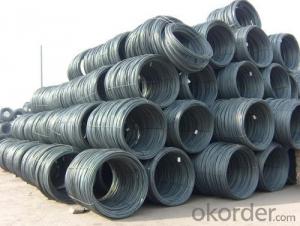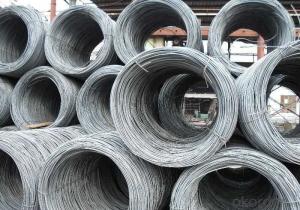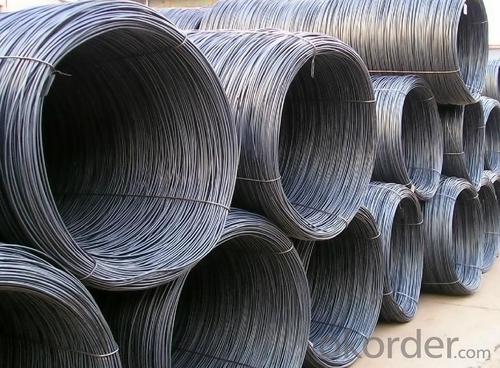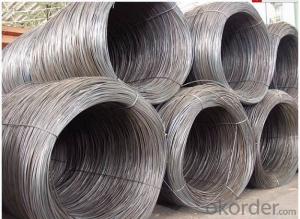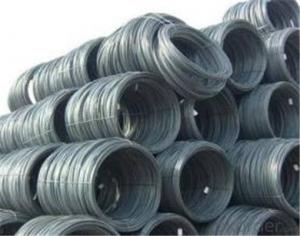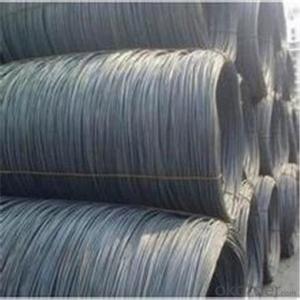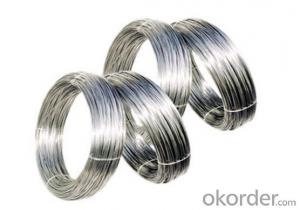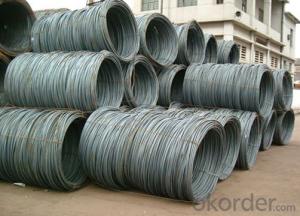High Quality Steel Wire Rod SAE1008 5.5mm
- Loading Port:
- Tianjin
- Payment Terms:
- TT or LC
- Min Order Qty:
- 50 m.t
- Supply Capability:
- 10000 m.t/month
OKorder Service Pledge
OKorder Financial Service
You Might Also Like
High Quality Steel Wire Rod SAE1008 5.5mm
Product Description:
Specifications of Wire Rod SAE1008:
Grade: SAE1008 Standard: ASTM
Diameter: 5.5mm
Alloy or Not: Alloy
Technique: Hot Rolled Place of Origin: China Mainland
Chemical Composition:
Please kindly find our chemistry of our material based on SAE1008 as below for your reference:
Grade | Chemical Composition (%) | |||||
C | Mn | S | P | Si | ||
SAE1008 | 0.10max | 0.32max | 0.045max | 0.040max | 0.30max | |
Mechanical properties | ||||||
Yield strength(N/mm2) | Tensile strength(N/mm2) | Elongation (%) | ||||
≥195 | 350-380 | ≥32 | ||||
Usage and Applications of High Quality Steel Wire Rod SAE1008 5.5mm:
After hot-rolled the products shaped into coil and delivery as finished product, including round, square,rectangular, hexagonal and so on. Since most of the products are round, it is generally called wire rod. Carbon steel wire rod is widely used in construction and manufacturing. Carbon steel wire rod is mainly used for reinforcement of reinforced concrete and welded structure or reprocessed (roberts , nail, etc.) materials, especially used to produce wire drawing, welding electrode, nails, spring, electronic, precise machinery parts and so on.
Packaging & Delivery of High Quality Steel Wire Rod SAE1008 5.5mm:
Packaging Detail: products are packed in coil and then shipped by container or bulk vessel
Each coil weight: About 2.05MT
Delivery Detail: within 45 days after received deposit or LC.
Label: to be specified by customer, generally, each bundle has 1-2 labels
Trade terms: FOB, CFR, CIF
FAQ:
Q1: Why buy Materials & Equipment from OKorder.com?
A1: All products offered byOKorder.com are carefully selected from China's most reliable manufacturing enterprises. Through its ISO certifications, OKorder.com adheres to the highest standards and a commitment to supply chain safety and customer satisfaction.
Q2: How do we guarantee the quality of our products?
A2: We have established an advanced quality management system which conducts strict quality tests at every step, from raw materials to the final product. At the same time, we provide extensive follow-up service assurances as required.
Q3: How soon can we receive the product after purchase?
A3: Within three days of placing an order, we will arrange production. The shipping date is dependent upon the quatity, how many sizes you want and the plan of production, but is typically 1 month to 2 month days from the beginning of production.
Images of High Quality Steel Wire Rod SAE1008 5.5mm:
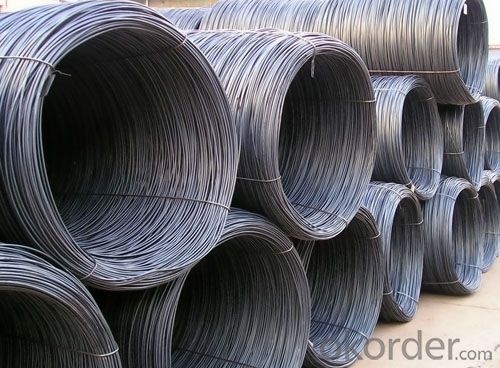
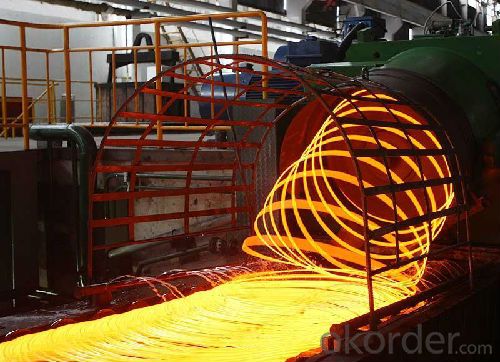
*If you would like to get our price, please inform us the size, standard/material and quantity. Thank you very much for your attention.
- Q: What are the different wear testing methods for steel wire rod?
- There are several different wear testing methods that can be used to evaluate the performance of steel wire rods. These methods are designed to simulate real-world conditions and assess the durability and wear resistance of the wire rods. Here are some of the commonly used wear testing methods for steel wire rods: 1. Pin-on-Disk Test: In this method, a pin-shaped sample of the steel wire rod is pressed against a rotating disk under controlled conditions. The wear and frictional properties of the wire rod can be measured by analyzing the wear scar on the disk. 2. Ball-on-Disk Test: Similar to the pin-on-disk test, this method involves placing a steel ball on a rotating disk. The wear and frictional behavior of the wire rod can be evaluated by measuring the wear scar on the disk caused by the interaction between the ball and the rod. 3. Abrasion Testing: This method involves subjecting the steel wire rod to abrasive conditions to evaluate its resistance to wear. The wire rod can be tested using methods such as the Taber abrasion test or the ASTM G65 test, where the rod is rubbed against an abrasive material or surface. 4. Sliding Wear Test: This test simulates the sliding motion between two surfaces. The steel wire rod is typically placed against a counter surface, and a controlled force is applied while the surfaces slide against each other. The wear and frictional properties of the wire rod can be measured based on the wear scar on the counter surface. 5. Wear Simulation in Real Applications: In some cases, wear testing can be performed by subjecting the steel wire rod to the actual application conditions. This could involve using the wire rod in a specific machinery or equipment, and then evaluating its wear resistance based on the observed wear and performance. These different wear testing methods enable researchers and manufacturers to assess the wear resistance and durability of steel wire rods under various conditions. By understanding how the wire rod performs in different wear scenarios, improvements can be made to the material composition or manufacturing processes to enhance its wear resistance and overall performance.
- Q: How is steel wire rod coated to prevent corrosion?
- There are several ways to prevent corrosion on steel wire rod. Galvanization is a common method, where the wire rod is dipped into molten zinc. This creates a protective layer that acts as a barrier between the steel and the corrosive elements in the environment. Another method involves applying different types of polymer coatings. These coatings can be sprayed, dipped, or electrostatically applied onto the wire rod. By doing so, a barrier is formed to prevent moisture and other corrosive substances from reaching the steel surface. In some cases, wire rods can be coated with a combination of zinc and polymer coatings to provide even greater protection against corrosion. The specific coating method chosen depends on factors such as the intended use of the wire rod and the level of corrosion resistance needed.
- Q: How is steel wire rod used in the manufacturing of wire for shopping baskets?
- Steel wire rod is an essential component in the manufacturing of wire for shopping baskets. It serves as the raw material that is transformed into wire through a series of manufacturing processes. The steel wire rod is first heated and then passed through a series of rollers to gradually reduce its thickness and increase its length. This process is known as drawing and it helps to improve the tensile strength and flexibility of the wire. Once the wire is drawn, it is typically coated with a protective layer to prevent corrosion and enhance its durability. This coating can be made of materials such as zinc or plastic. The coated wire is then shaped into the desired form, which in the case of shopping baskets, is usually a mesh-like structure. This shaping is done through a process called welding, where the wire is bent and joined at specific points to form the basket shape. The steel wire rod used in the manufacturing of wire for shopping baskets is chosen for its strength, resilience, and ability to withstand heavy loads. It ensures that the shopping baskets are sturdy enough to carry various items without bending or breaking. Additionally, the steel wire rod's corrosion resistance properties ensure that the wire and ultimately the shopping baskets have a longer lifespan, even when exposed to moisture or harsh environments. In summary, steel wire rod plays a crucial role in the manufacturing of wire for shopping baskets. It provides the raw material needed to produce the wire, which is then coated, shaped, and welded to create the final product. The strength, resilience, and corrosion resistance of the steel wire rod ensure that the shopping baskets are durable, long-lasting, and capable of withstanding the demands of everyday use.
- Q: What are the main factors influencing the choice of steel wire rod order warranty claims process?
- The main factors influencing the choice of steel wire rod order warranty claims process include the quality of the wire rod, the reputation and track record of the supplier, the terms and conditions of the warranty, the cost and convenience of the claims process, and the level of customer support provided by the supplier.
- Q: How is steel wire rod coated for corrosion protection?
- Steel wire rod is coated for corrosion protection through a process called galvanization. This involves immersing the wire rod in a bath of molten zinc, which forms a protective layer over the surface of the steel. The zinc coating acts as a barrier, preventing contact between the steel and corrosive elements, thereby significantly reducing the risk of corrosion.
- Q: How is steel wire rod used in the manufacturing of bicycle spokes?
- Steel wire rod is used in the manufacturing of bicycle spokes by being shaped and cut into the desired lengths. These rods are then threaded into the spoke nipples and attached to the bicycle hub and rim, providing strength and stability to the wheel structure.
- Q: What are the common applications of carbon steel wire rod?
- Due to its exceptional mechanical properties and versatility, carbon steel wire rod is extensively utilized in various industries. Here, we present some common uses of carbon steel wire rod: 1. Construction: The construction industry heavily relies on carbon steel wire rod to reinforce concrete structures. It is commonly employed in the production of wire mesh, reinforcement bars, and pre-stressed concrete products. 2. Automotive: In the automotive sector, carbon steel wire rod is employed to manufacture springs, suspension components, and wire harnesses. Its remarkable strength and flexibility make it an ideal choice for these applications, ensuring reliable performance and durability. 3. Manufacturing: Carbon steel wire rod is widely employed in several manufacturing processes, including wire drawing, cold heading, and cold forging. It is commonly used to produce fasteners, bolts, nuts, and other small metal components. 4. Agriculture: The agricultural industry extensively utilizes carbon steel wire rod for applications such as fencing, vineyard trellising, and animal enclosures. With its high tensile strength and corrosion resistance, it proves to be an ideal material for outdoor use. 5. Wire Products: Carbon steel wire rod serves as the primary raw material for the production of a wide range of wire products, including cables, wire ropes, and galvanized wires. These products find applications in industries such as telecommunications, construction, and manufacturing. 6. Energy and Power: The energy and power sector relies on carbon steel wire rod for manufacturing electrical transmission and distribution lines. It provides the necessary strength and conductivity required for efficient power transmission. 7. Furniture and Household Goods: Carbon steel wire rod is utilized in the production of furniture, kitchenware, and other household goods. Its ability to be shaped into various forms provides structural support and durability to these products. In conclusion, carbon steel wire rod finds extensive applications in the construction, automotive, manufacturing, agriculture, wire products, energy and power, as well as furniture and household goods industries. Its mechanical properties, versatility, and cost-effectiveness contribute to its popularity in various applications.
- Q: How is steel wire rod used in the manufacturing of wire for bicycle spokes?
- Steel wire rod is an essential component in the manufacturing of wire for bicycle spokes. It serves as the raw material from which the wire is produced. The process begins with the steel wire rod being drawn through a series of dies to reduce its diameter and increase its length. This drawing process helps to strengthen the wire and improve its overall quality. Once the wire has been drawn to the desired diameter, it is then further processed to make it suitable for bicycle spokes. This involves a process called cold forging, where the wire is bent and shaped into the desired form. Cold forging helps to enhance the wire's strength and durability, ensuring it can withstand the rigors of bicycle use. After the cold forging process, the wire is often subjected to additional treatments, such as heat treatment or galvanization. Heat treatment helps to further strengthen the wire, while galvanization involves coating the wire with a layer of zinc to protect against corrosion. The final step in the manufacturing of wire for bicycle spokes involves cutting the wire to the desired length and threading it onto a spoke nipple. This completes the production process, resulting in a strong and reliable wire that can be used to build sturdy and durable bicycle spokes. In summary, steel wire rod plays a crucial role in the manufacturing of wire for bicycle spokes. It serves as the starting material, undergoes various processes to enhance its strength and durability, and ultimately forms the backbone of a reliable and high-quality spoke.
- Q: What are the typical chemical compositions of steel wire rod?
- The typical chemical compositions of steel wire rod vary depending on the specific grade and desired properties. However, commonly used compositions include carbon (0.06-0.25%), manganese (0.30-1.00%), silicon (0.10-0.30%), sulfur (0.05% max), and phosphorus (0.04% max). Other elements like chromium, nickel, and copper may also be present in smaller amounts to enhance certain properties.
- Q: What are the different surface cleaning agents used for steel wire rod?
- There are several different surface cleaning agents that can be used for steel wire rod. Some common ones include pickling agents, acidic cleaners, alkaline cleaners, and degreasers. These agents are used to remove any dirt, grease, rust, or other contaminants from the surface of the steel wire rod, ensuring a clean and smooth surface for further processing or application.
Send your message to us
High Quality Steel Wire Rod SAE1008 5.5mm
- Loading Port:
- Tianjin
- Payment Terms:
- TT or LC
- Min Order Qty:
- 50 m.t
- Supply Capability:
- 10000 m.t/month
OKorder Service Pledge
OKorder Financial Service
Similar products
Hot products
Hot Searches
Related keywords
